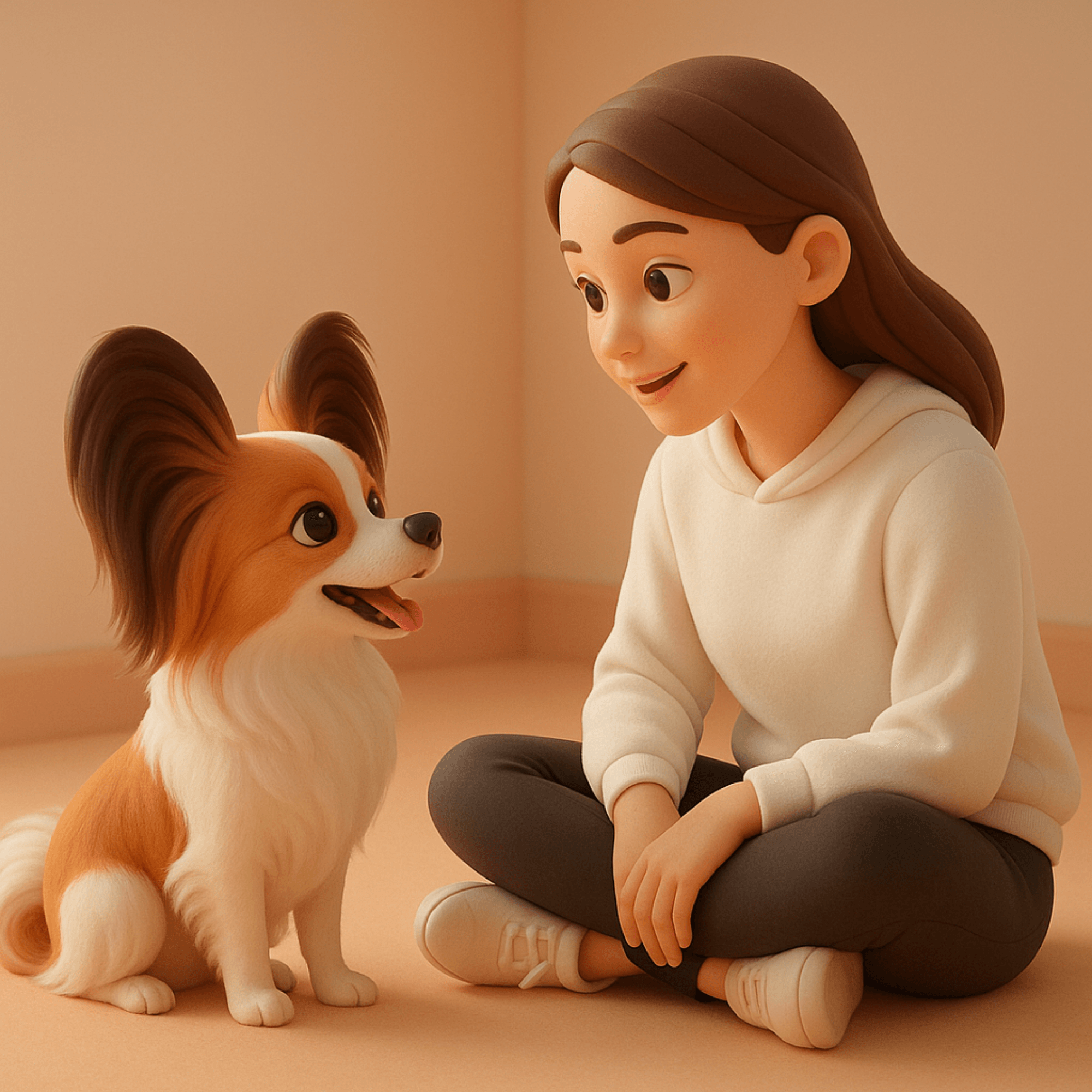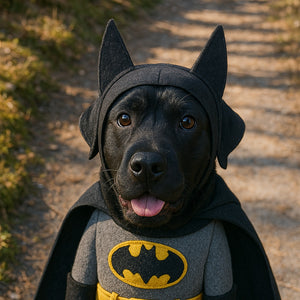
🐾 Why Does Your Dog Follow You? 7 Reasons Why They Never Let You Out of Their Sight
Does your dog follow you everywhere – to the kitchen, the bathroom, and even when you get up from the couch? Do you sometimes feel like you can't even make a cup of tea without the help of four paws? While this behavior can be adorable and sweet, it can also raise questions: is this normal? is your dog bored? is he missing something?
This behavior is common and natural – but its causes can vary greatly. Sometimes it's an expression of love, other times a need for security, and sometimes it's fear, boredom, or... a habit we've formed ourselves.
In this article, we'll look at the 7 most common reasons why your dog follows you around like a shadow. We'll also explain when this is completely normal and when it's worth taking a closer look at your pet's emotions and needs.
In this article, we'll explore the seven most common reasons why a dog follows you around like a shadow. Some stem from a deep bond, others from instinct, and still others from a need for attention, excitement, or... boredom.
❤️ 1. Strong emotional bond
Your dog may be following you because they simply love you. Dogs are social animals that form strong bonds with their owners. Studies show that interacting with their owners increases oxytocin levels—a hormone associated with trust and attachment—in both dogs and humans. Following you is a natural way to express love and a need for closeness.
🐺 2. Herd instinct and sense of security
Dogs descend from wolves, which lived in organized packs and operated as a team. To a dog, its guardian is the "alpha"—the leader of the pack. Following you around the house gives the dog a sense of control and security. It's a sign that it trusts you and feels comfortable being close.
🎲 3. Boredom and lack of stimulation
If your dog doesn't get enough physical and mental activity, he might start looking for something to do – and you might be that activity. He follows you because he doesn't know what else to do. He's waiting for something to happen – play, an outing, a treat. This is a signal that he might need enrichment.
🦴 4. Seeking reward or attention
If every time your dog follows you, you give him attention, petting, or a treat, you're reinforcing that behavior. Even accidentally. Dogs learn by association. A few repetitions are enough for the dog to recognize that "following a person = something cool is happening."
👀 5. Curiosity and the need for control
Dogs are incredibly curious. They want to know what you're doing, where you're going, and what you're carrying. For many dogs, observing their owner isn't just a chore, but a pleasure and a way to learn about their daily routine. Following you may stem from a desire to understand your schedule.
🧬 6. Racial trait or genetic condition
Some dog breeds have been bred specifically to work closely with humans—for example, Border Collies, Labradors, and Australian Shepherds. In these dogs, the need to "be with people" is much stronger and more natural than in independent dogs, such as Chow Chows.
😟 7. Separation anxiety
In some cases, constant following can be a sign of separation anxiety. A dog doesn't want to be left alone because it feels anxious when its owner is out of sight. This often happens with adopted dogs, those who have experienced trauma, or those who have been with their owners for a long time. If a dog shows signs of stress, destroys objects, or barks when left alone, it's worth consulting a behaviorist.
📊 Is this common? What do the statistics say?
While exact numbers are difficult to obtain for all breeds and homes, studies and pet owner surveys indicate that owner stalking is one of the most common everyday behaviors observed in dogs .
- According to the American Kennel Club, over 60% of dog owners say their pet follows them everywhere around the house .
- Breeds such as the Border Collie, Golden Retriever and Australian Shepherd show an increased need for closeness – this is confirmed by the observations of both behaviorists and owners.
- In dogs struggling with separation anxiety, tracking may occur up to 100% of the time when the owner is home.
It's a common phenomenon – but its intensity, motivations and impact on a dog's well-being can vary greatly.
📷 What does a dog see when he looks at you?
For a dog, looking at you isn't just an observation—it's a process of interpreting your posture, tone of voice, emotions, and intentions. Dogs have an extraordinary ability to read our body language and mood. When they look at you, they're looking for clues: what's about to happen? Are you calm, excited, or nervous?
They see your hand movement, your raised eyebrows, the rhythm of your steps. They feel the tension in your body even before you issue a command. Sometimes, a single gesture is enough for a dog to know: "We're going for a walk," "dinner's coming," or "It's best not to come any closer."
For many dogs, looking at their owner isn't just about tracking—it's their way of understanding the world. And you—even unconsciously—are their most important source of knowledge about reality.
Yes, a dog's age plays a huge role in how and why it tracks us. Puppies behave differently than adult dogs, and senior dogs behave differently still. Understanding age differences can help you more accurately interpret your pet's behavior.
- Puppies and young dogs – this is the most curious and anxious stage of life. Puppies learn through observation and usually cling to their caregivers as a source of security. This is also a time of intense bonding.
- Adult dogs are usually able to rest on their own and understand household routines. If they still follow you, it may be due to emotional needs, habits, or a specific breed trait.
- Seniors – Older dogs can become more clingy and prone to anxiety. Loss of hearing, vision, or orientation can make your dog feel more secure when you're within reach.
As a dog ages, its needs change, and tracking can be a form of communication, a request for support, or simply a desire for closeness.
In most cases, following a handler is a healthy sign of attachment, curiosity, and a need to be part of the "pack." Dogs are social by nature—they want to be where life is happening. They follow us not because they expect something, but because they feel safe with us.
However, this boundary can be crossed. Behavior that initially seems charming can be a symptom of anxiety or insecurity if it escalates into overdependence. Pay attention to the following:
- Ca n't your dog fall asleep in another room?
- Does he keep looking you in the eye , even when you're not saying anything?
- Does he ignore toys and rest just to watch you?
- Does he get nervous when you're out of his sight, even for a moment?
If the answer to most of these questions is "yes," it's a sign that it's worth starting to support your dog in building emotional independence . This doesn't mean you should ignore him—quite the opposite. The point is to teach your dog that time spent alone can be enjoyable and safe.
Teach your dog to rest in one spot, use scent mats, and introduce relaxation rituals – all to let your dog know he doesn't have to constantly follow you around to be loved. Change his habits slowly and carefully. If necessary, consult a behaviorist who can help him work through any separation anxiety.
✅ How to react?
💡 How to teach your dog to rest – step by step
If you want your dog to be able to rest on his own, you need a simple and calming plan. Here's an effective, proven method:
- Create a relaxation zone – choose a place where your dog can relax (e.g., a bed, mat, kennel with an open door).
- Reinforce positive associations – provide treats, scented toys, and chews there. Make this place a pleasant place.
- Teach the “stay” command – lead your dog to the resting area, say the command, and reward him for staying.
- Increase the distance and time – When your dog stays put, move away for a moment. Gradually increase the time and distance without causing anxiety.
- Don't come back when called – if your dog gets up, wait until he lies down again. Teach him that rest and quiet are rewarded.
- Practice relaxation rituals at the same time each day, in a peaceful atmosphere. This could be after a walk, with soothing music playing.
Remember: learning to rest is not only comfortable for you, but also a huge benefit for your dog – it teaches him self-regulation, independence and builds a sense of security.
Keeping an eye on your owner can be adorable, but if you notice your dog can't seem to relax when he's not right by your side, it's worth taking action. The key is to consciously create a balance between closeness and independence .
Here's how you can support your dog:
- Remain calm and neutral when your dog is following you. Don't react enthusiastically or punish – this only reinforces the behavior.
- Don't randomly reinforce behavior – don't give him a treat, pet him, or say "come on" every time he follows you.
- Make sure your dog gets a daily dose of exercise and play – a dog that is running and tired is a calmer and less “controlling” dog.
- Introduce independence exercises – for example, leaving your dog with a safe toy in another room for a few minutes.
- Practice the “go” and “stay” commands – reward your dog when he rests away from you.
- Reinforce positive resting habits – sniffing mats, chew toys, and licking toys (e.g. lick mats) are great for keeping your dog occupied and building positive associations with solitude.
- Use relaxation rituals – e.g., calm music, fixed hours for walks and rest.
- If necessary, seek help from a trainer or behaviorist , especially if your dog shows signs of separation anxiety.
It's a process that requires consistency and empathy, but it yields results. A dog that learns that it doesn't have to be constantly nearby will gain a new sense of security.
❓ Frequently asked questions (FAQ)
Why does my dog follow me everywhere – even to the bathroom?
This is a natural behavior stemming from bonding, herding instincts, or a need for stimulation. A dog feels safe when you're close.
Is following your caregiver a sign of a behavioral problem?
Not always. If a dog can rest independently and doesn't panic when separated, this is normal. Problems arise when the behavior is accompanied by stress, tension, or a lack of independence.
Which breeds most often follow humans?
Labrador Retriever, Border Collie, Golden Retriever, Australian Shepherd – these are breeds strongly oriented towards cooperation with humans.
Is it possible to "wean" my dog from following me?
It's not so much about breaking the habit as it is about teaching them that resting away from their caregiver is also safe. On-site training, enrichment, and routines will help.
Do puppies track more than adult dogs?
Yes – they are more dependent, curious, and learn about the world through observation. Over time, with good guidance, they learn to be independent.
🧠 Summary
A dog that follows you is saying one thing: "You are important to me." But as in any relationship – including interspecies ones – balance is key. Following you can be an expression of attachment, curiosity, or a need for security, but it can also be a symptom of boredom, anxiety, or a lack of stimulation.
Understanding the motivations behind this behavior is the first step to better communication with your dog. It's also an opportunity to consciously support their emotional and behavioral needs—not by suppressing them, but by nurturing them in a healthy way.
Not every shadow has to be a problem. Sometimes it's simply an expression of love. But love also means helping your dog build independence and self-confidence. Because a dog that knows it can be close, but doesn't have to be, is a dog that trusts, feels calm, and emotionally stable .
Observe, analyze, and support your pet with care, consistency, and understanding. This attitude builds not only obedience but, above all, a relationship full of respect and trust.
Sources:
📚 Additional materials
- How to Tell If Your Dog Is Bored: 10 Signs You Can't Ignore
-
TOP 10 Most Intelligent Dog Breeds – Which Ones Will Surprise You With Their Cleverness?
- 🏙️ Best dogs for apartments – breed ranking
- 💬 How Do Dogs Show Affection? Signals You Should Know
- 🐕 Is your dog pulling on the leash? Find out how to fix it.
- 🚗 How to safely transport a dog in a car?
- 🐾 How to teach your dog to stay home alone
- 🛏️ Can a dog sleep in bed with its owner? Facts, myths, and behavioral advice.
See more at: Petto.com.pl


























 https://petto.com.pl
https://petto.com.pl